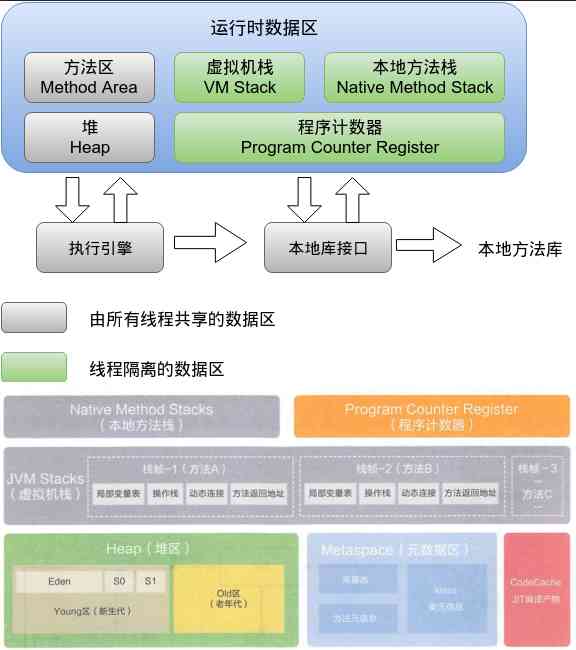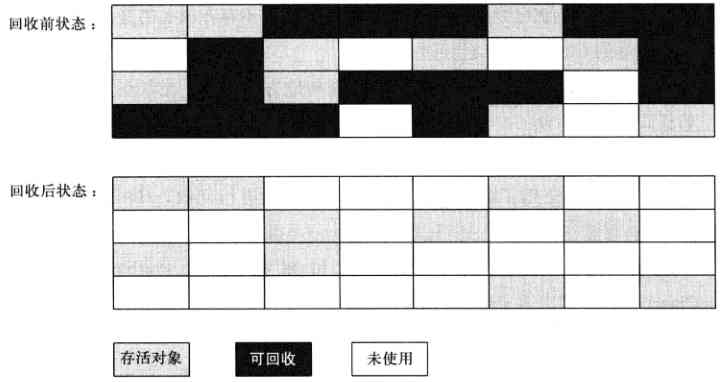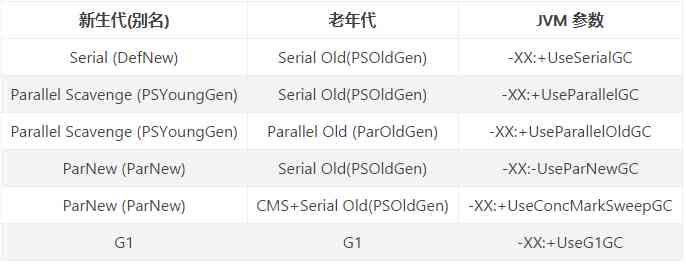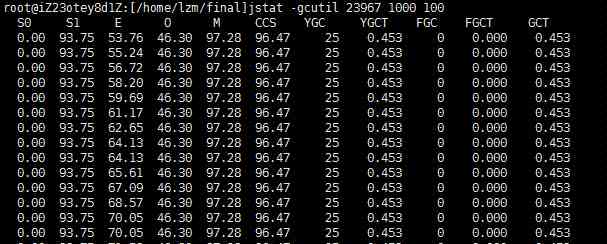当前位置:网站首页>JVM memory area and garbage collection
JVM memory area and garbage collection
2020-11-06 01:18:00 【Clamhub's blog】
1、JAVA Memory area and memory overflow
1.1、 summary
Java in JVM Memory management mechanism is provided ,Java Virtual machine is executing Java During the process of the program, the memory is divided into different data areas , Pictured :
1.2、 Program counter
Program counter is the line number indicator of bytecode executed by the current thread , The function is to get the next bytecode instruction to be executed according to the counter value . When it comes to java Method , It records the address of the executing virtual machine bytecode instruction , If it is Native Method , Then the value of this counter is null . There is no such thing as OutOfMemoryError.
1.3、 Virtual machine stack
Every ordinary Java Method ( remove Native Method ) The stack frame will be created at the same time during execution , Used to store local variables 、 Stack operation 、 Dynamic links 、 Method exit information , Each method is called until the completion of the process corresponding to the stack frame in JVM Stack in and stack out . The memory space required by the local variable table is allocated among compilers .
There are two types of exceptions associated with the virtual machine stack :
- StackOverflowError
The stack depth of thread request is greater than the maximum depth allowed by virtual machine .
- OutOfMemoryError
The virtual machine stack cannot be extended to enough memory .
1.4、 Native Method Stack
For virtual machine execution Native Method , The others are the same as the local method stack . There will be StackOverflowError and OutOfMemoryError.
1.5、 Pile up
Create a heap after the virtual machine starts , For storing object instances . The heap is the main working area of the garbage collector , Mainly divided into the new generation and the old generation , The new generation can be subdivided into Eden Space 、From Survivor Space 、To Survivor Space .java Program startup , You can use -Xmx And -Xms Control the size of the heap . If there is no memory in the heap to complete the instance allocation and the heap cannot be expanded, it will be thrown OutOfMemoryError.
1.6、 Method area
The method area mainly stores the metadata of the class , Such as class information loaded by virtual machine 、 Constant 、 Static variables 、 Real time compiler compiled code ,JDK1.8 It was realized by permanent replacement ,JDK1.8 Then use Metaspace , And Metaspace uses system memory . If you can't request memory , Will throw out OutOfMemoryError.
2、 Garbage collection
2.1、 How to judge that the object has died ?
2.1.1、 Reference counting
Add a reference counter to the object , When there's a place to quote , Counter value +1, When the reference fails , Counter value -1. The counter for 0 The object of death is , But there's a problem : Object circular reference , Two objects refer to each other , The reference counter that causes them is not 0, So I can't tell GC Recycling .
2.1.2、GC Roots Search for
Java It is used in GC ROOT Search for , The idea is to go through a series called “GC Roots” As the starting point , Start with these nodes and drill down , The path in search is called the reference chain , When GC Roots When you can't reach an object , The object is not available .
GC Roots These include the following :
- Objects referenced in local variable table in stack frame
- Object referenced by a class static property in a method area
- The object referenced by a constant in the method area
- Native Method Stack Native Method reference object
2.2、 Garbage collection algorithm
2.2.1、 Mark - Clear algorithm
Mark - The clearing algorithm is divided into two stages :
- Mark : First mark all objects to be recycled .
- eliminate : Uniformly reclaim marked objects .

This algorithm has two disadvantages :
- The efficiency is not high
- It will generate discontinuous memory fragments
2.2.2、 Copy algorithm
The replication algorithm is very efficient , It divides the available memory into two equal sized blocks according to the capacity , Use only one piece at a time , When one piece is used up , Copy the surviving objects to another piece , Then clear the used memory space .

This algorithm is very suitable for recycling the new generation , In the new generation, it is divided into Eden Space 、From Survivor Space 、To Survivor Space , Generally, the proportion of allocated memory is 8:1:1, When recycling , take Eden And From Survivor Objects that are still alive in are copied to To Survivor in , Then clean up Eden And From Servivor Space , When To Survivor When there is not enough space , Need to rely on the old age .
2.2.3、 Mark - Sorting algorithm
In the old age , The survival rate of the subjects is relatively high , So mark - The sorting algorithm has been proposed , First mark the objects to recycle , Then move all living objects to one end , And then clean up the dead :

2.2.4、 Generational collection algorithm
The idea of generational recycling is based on the life cycle of the object , Divide different memory into several pieces , According to the characteristics of each block of memory, the appropriate collection algorithm , For example, the new generation uses replication algorithm , The old days use signs - Sorting algorithm .
2.3、 Garbage collector
The following figure shows 7 Different generations of collectors , If there is a connection between the two collectors , Can be used with .

You can view the garbage collector information through the following command :
1 |
java -XX:+PrintCommandLineFlags -version |
My test server results :
1 |
-XX:InitialHeapSize=524503488 -XX:MaxHeapSize=8392055808 -XX:+PrintCommandLineFlags -XX:+UseCompressedClassPointers -XX:+UseCompressedOops -XX:+UseParallelGC |
It can be seen that :ParallelGC.
JVM Parameter correspondence :

Here is a brief introduction to 7 A garbage collector :
2.3.1、Serial The collector
A new generation of single-threaded collectors , A simple and efficient .
2.3.2、ParNew The collector
Serial Multithreaded version of collector , In addition to multithreading in garbage collection , The rest go with Serial The collectors are the same .
2.3.3、Parallel Scavenge The collector
Parallel Scavenge Collector is a new generation of parallel collector which adopts replication algorithm , Focus on the throughput of the system , Tasks that are suitable for background computing without too much user interaction .
2.3.4、Serial Old The collector
Serial Old It's a single threaded old-fashioned garbage collector , Use the tag - Sorting algorithm . It is simple and efficient .
2.3.5、Parallel Old The collector
Parallel Old The collector is Parallel Scanenge The old version , Multithreaded garbage collection , It's also marked - Sorting algorithm .
2.3.6、CMS The collector
CMS Focus on service response time , It's based on markers - Clear algorithm implementation . With concurrent collection 、 The characteristic of a low pause .
2.3.7、G1 The collector
Garbage First, Based on tags - Sorting algorithm , It will Java Pile up ( Including the new generation and the old generation ) It is divided into several independent areas of fixed size , And keep track of the amount of garbage in these areas , Maintain a priority list in the background , Each time according to the allowed collection time , Priority to recycle the most garbage .
3、CPU High occupancy troubleshooting
3.1、 linux View process information
1 |
top |

3.2、 View process occupancy cpu Most threads
1 |
ps -mp 23967 -o THREAD,tid,time |

3.3、 Threads ID turn 16 Base number
1 |
printf "%x\n" 23968 |

3.4、 View thread information
1 |
jstack 23967 |grep -A 10 5da0 |

1 |
jstack 23967 |grep 5da0 -A 30 |

3.5、 View the object information of the process
1 |
jmap -histo:live 23967 | more |

3.6、 View the progress of GC situation
1 |
jstat -gcutil 23967 1000 100 |

Reference resources
utilize jmap and MAT Wait for tools to check JVM Runtime heap memory

版权声明
本文为[Clamhub's blog]所创,转载请带上原文链接,感谢
边栏推荐
- High availability cluster deployment of jumpserver: (6) deployment of SSH agent module Koko and implementation of system service management
- 在大规模 Kubernetes 集群上实现高 SLO 的方法
- 中小微企业选择共享办公室怎么样?
- 比特币一度突破14000美元,即将面临美国大选考验
- Wiremock: a powerful tool for API testing
- 遞迴思想的巧妙理解
- Examples of unconventional aggregation
- Using consult to realize service discovery: instance ID customization
- C++和C++程序员快要被市场淘汰了
- 使用 Iceberg on Kubernetes 打造新一代云原生数据湖
猜你喜欢

Working principle of gradient descent algorithm in machine learning

Vue 3 responsive Foundation

条码生成软件如何隐藏部分条码文字

向北京集结!OpenI/O 2020启智开发者大会进入倒计时

Kitty中的动态线程池支持Nacos,Apollo多配置中心了

Aprelu: cross border application, adaptive relu | IEEE tie 2020 for machine fault detection

Filecoin的经济模型与未来价值是如何支撑FIL币价格破千的

助力金融科技创新发展,ATFX走在行业最前列

连肝三个通宵,JVM77道高频面试题详细分析,就这?

至联云分享:IPFS/Filecoin值不值得投资?
随机推荐
人工智能学什么课程?它将替代人类工作?
03_ Detailed explanation and test of installation and configuration of Ubuntu Samba
Swagger 3.0 天天刷屏,真的香嗎?
选择站群服务器的有哪些标准呢?
你的财务报告该换个高级的套路了——财务分析驾驶舱
GUI 引擎评价指标
Flink on paasta: yelp's new stream processing platform running on kubernetes
Network security engineer Demo: the original * * is to get your computer administrator rights! 【***】
如何将数据变成资产?吸引数据科学家
中国提出的AI方法影响越来越大,天大等从大量文献中挖掘AI发展规律
速看!互联网、电商离线大数据分析最佳实践!(附网盘链接)
直播预告 | 微服务架构学习系列直播第三期
(2)ASP.NET Core3.1 Ocelot路由
100元扫货阿里云是怎样的体验?
PN8162 20W PD快充芯片,PD快充充电器方案
Wiremock: a powerful tool for API testing
Basic principle and application of iptables
Serilog原始碼解析——使用方法
High availability cluster deployment of jumpserver: (6) deployment of SSH agent module Koko and implementation of system service management
快快使用ModelArts,零基礎小白也能玩轉AI!